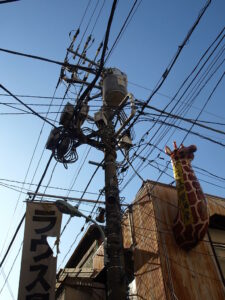Audio and ElectroMagnetic Compatibily
What is “electromagnetic compatibility”? Does it serve any purpose nowadays, or is it an anachronism? Why most consumer electronics cannot withstand a lightning strike into the surrounding power grid and why do people in densely populated areas need stronger and stronger Wi-Fi? Does electromagnetic radiation (“electrosmog”) affect living organisms?
The issues fitting within the internationally recognised abbreviation EMC constitute to a very complex field. EMC closely affects all of us, logically especially these days, at the time when electronics is present in pretty much all areas of our life. EMC will prevent your neighbour from disturbing your television when she blow-dries her hair.
Every electrical appliance emits electromagnetic radiation to the surrounding area. At the same time, such appliance is affected by other appliances around it. The EMC standard defines limits for the level of radiation that an appliance can emit and also for the level of radiation that it has to withstand.

Image: Ventus CC BY-SA 3.0 , via Wikimedia Commons
History
As an independent scientific and technical discipline, electromagnetic compatibility originates in the USA of the 1960s. For a very long time, it has been an interest of just a narrow circle of experts from the military and aerospace industries. With the rapid development of electronics (especially microprocessor and communication technologies) in the last few decades, and its anchoring in our everyday lives, the EMC field concerns all of us more and more.
In 1968, H. M. Schilke, one of the EMC founders, said that even a completely reliable system would be virtually worthless in actual operation, unless it was electromagnetically compatible. Reliability and electromagnetic compatibility were inseparable system requirements, if the system was supposed to work at all times and in all circumstances.
The Outcomes of Non-compliance with EMC in Practice
The consequences of low durability and the overall non-compliance with the EMC standard can be even tragic:
- A diagnostic set at an intensive care unit in a Prague hospital monitored breathing, pulse and temperature of patients. Other switched-mode appliances interfered with the cardioscope, showing additional pulses evaluated as non-synchronic heartbeat. A faulty starter of a nearby lamp switched every second, blocking the measuring. It made the set produce false reports of exceeding the heart rate limit. The whole set had to be replaced due to its completely inadequate tolerance to electromagnetic radiation.
- The destruction of a NATO Tornado fighter aircraft in 1984. The cause of the disaster was an interference of the electronic control system with electromagnetic waves. Flying over a high-power transmitter at the height of 230 m and at the speed of 800 km/h near Munich, Germany, the autopilot system failed and the aircraft crashed.
- The sinking of a British cruiser Sheffield during the Falkland War. The ship’s communication system and its anti-aircraft system used to interfere with enemy missile navigation were not electromagnetically compatible. The system caused such problems that it had to be switched off during communication with the UK command. In such a moment, an Argentinian aircraft fired a missile which sank the cruiser.
- Pershing II type rocket accident in Germany. It was unintentionally fired by an electrostatic discharge from a thunderstorm which occurred during transportation.
- Iron works accident on the east coast of the USA in 1983. A handheld transceiver interfered with the microprocessor control system of a crane carrying the casting pan with liquid iron, which capsized.
- A collapse of a central control system of mining mechanisms at a mining region in the Czech Republic. A 3,4 MW mining machine was connected to a 35 kV grid. The propulsion mechanism with a disturbing feedback caused a crash of the control system (and hence of itself) in the entire region.
- A similar situation occurred in a sugar refinery in Mělník, Czech Republic. New machines with 200 kW converters were connected directly to a 22 kV grid without proper filtration and compensation (a common practice at the time), causing high fluctuations and deformations of the power supply and subsequently a failure of themselves.
The Present
European legislature defines the issues of EMC with a primary norm IEC 1000-1-1 and other related norms. In short, the idea is that every electrotechnical device that we buy has to be usable in a particular given environment. For home environment, this includes appliances ranging from an electric toothbrush, through a computer, television, microwave, all the way to an induction hob.
Let’s take a short look at the criteria that EMC secures for our home appliances. As the majority of consumer electronics manufacturers aim for the lowest possible production cost, the construction criteria are pushed to the very limits of the mandatory standards. The consumer is left to deal with the assumption that after some time, the product will have to be thrown away, in the best case to a sorted waste container.
Immunity
A device has to be sufficiently resistant to interference from the air, the power grid and to possible overvoltage in the power grid.
- Harmonic and interharmonic voltage in the power grid (EN 61000-4-7)
- Short-term drops and interruptions in the power voltage (EN 61000-4-11)
- A voltage and current pulse (IEC 1000-4)
- High energy pulse of voltage and current (EN 61000-4-5)
- Groups of rapid transient phenomena (fast transients—BURST) (EN 61000-4-4)
- Attenuated oscillation waves (EN 61000-4-12)
- Electrostatic discharges (EN 61000-4-2)
- Magnetic fields (EN 61000-4-8, EN 61000-4-9, EN 61000-4-10)
- High frequency electromagnetic fields (EN 61000-4-3)
Interference
We measured interference in the grid in practice. You can read about it here.
The interference produced by a device must not exceed the values defined by the following norms:
- Compatible levels for low frequency interference transmitted by line (EN 61000-2-2)
- A description of the environment of radiated phenomena and phenomena disseminated by lines not related to the network frequency (IEC 1000-2-3)
- Limits for harmonic current emissions (EN 61000-3-2)
- Limiting voltage changes, voltage fluctuations and flicker (EN 61000-3-3)
- EMC requirements for household appliances, power tools (EN 55014-1)
- And more…

Image: Grethe Spongsveen CC BY-SA 4.0 , from Wikimedia Commons
EMC of Biological Systems
deals with the overall “electromagnetic background” of the environment we live in. That includes permissible levels of both interfering and useful electromagnetic signals (natural and artificial). All with regard to their influence on living organisms. To date, biophysical research is not unambiguous in the area of electromagnetic radiation impact on humans and other organisms. Biological effects of an electromagnetic field depend on many variables. They include the character of the field, the exposure time, or different properties of the organism. As we do not know of any biological receptors of the field, the evaluations of the effects are based on non-specific reactions of the organism.
Every person’s reactions to the effects of electromagnetic field are different. Everybody’s adaptive, compensatory and regenerative abilities and possibilities are strictly individual. It is very difficult to arrive to generally applicable outcomes based on statistic results from an analysis of the changes in an organism. Therefore, there are only a few specific clinical studies. Those that do exist deal primarily with greater expositions to electromagnetic field, typically in a work environment. Nevertheless, today’s potential undesirable effects may include more. The workplace (transmitter and radar crews, etc.) is not the only place with exposition to electromagnetic field. The modern living environment brings long term exposure to our own home devices. And on top of that, the Wi-Fi signal from the neighbours, the signal of multiple mobile operators, etc.
Several medical research institutes deal with the EMC of biological systems. Their goals include assessing the tolerance of human organism to electromagnetic influences and clarifying the mechanisms of their effects. With high frequency and microwave fields, tissue heating effects are relatively clarified. The effects of the electromagnetic field on the central nervous system, cardiovascular, hematopoietic and immune systems are attributed to so-called non-thermal effects—long lasting expositions to fields with low power levels. Nevertheless, these, or any genetic or carcinogenic effects have not been unambiguously proven. The inconsistencies in research have left their mark. When it comes to “acceptable doses,” there are large differences throughout the hygienic standards around the world.
Links
en.wikipedia.org/wiki/Electromagnetic_compatibility
www.elektrorevue.cz/clanky/01025/index.html (in Czech)
www.elektrorevue.cz/clanky/01036/index.html (in Czech)
www.elektrorevue.cz/clanky/01021/index.html (in Czech)
www.radio.feec.vutbr.cz/emc/index.php?src=node73 (in Czech, offline)
Our power line filters for audio
Newsletter
We'll let you know about our participation in audio shows, new reviews and products, new places to listen to your speakers, or new posts on our blog. We won't spam you.